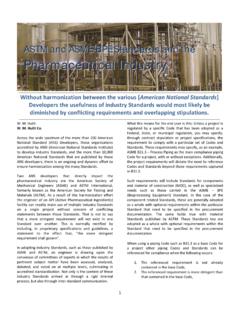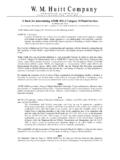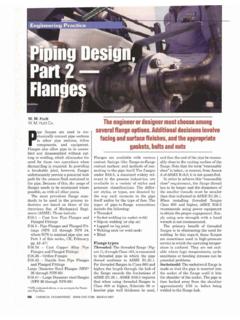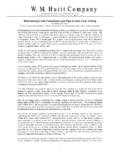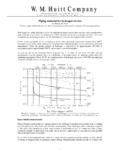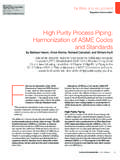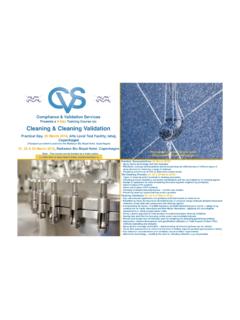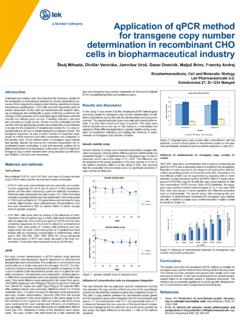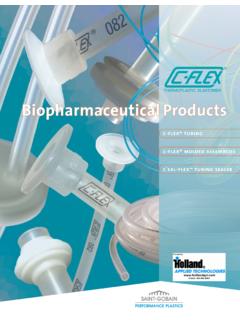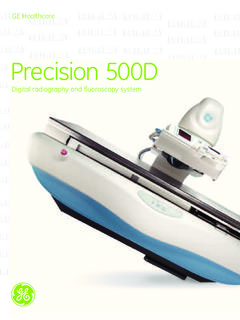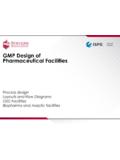Transcription of Piping Design Part 1: The Basics - W. M. Huitt Co
1 As published in the February and March 2007 issues of Chemical Engineering Magazine With regard to material of construction, the ongoing evolution of technology has raised expectations throughout William M. (Bill) Huitt W. M. Huitt Co. This is the first in a series of three articles that will cover a wide range of Piping topics. Topics that will cross industry lines to include chemical, petroleum refining, pharmaceutical, and other industries as well. It will be the intent of these articles to address questions and misunderstandings as they relate to industry on a general basis.
2 Pipe is pipe . This is a euphemism (jargon if you will) quite often used among Piping designers and engineers. Taken at face value, this is a true is certainly pipe. However, taken in context, it means that no matter which industry you work in when designing Piping systems it s all the same. And in that context it could not be further from the truth. The pharmaceutical industry, in its current state of growth, is a relative new comer to Design , engineering and construction compared to the oil refining, bulk chemical, pulp & paper and nuclear industries.
3 As a frame of reference the American Society of Mechanical Engineers (ASME) was established in 1880; the American Petroleum Institute (API) was established in 1919; 3-A Standards (for food & dairy) were first developed in the 1920 s; the ASME committee for BPVC (Boiler Pressure Vessel Code) Section III for nuclear power was proposed in 1963; Semiconductor Equipment and Materials Institute (SEMI) was established in 1973; the International Society of Pharmaceutical Engineers (ISPE) was established in 1980; and ASME Biopharmaceutical Equipment (BPE) issued its first Standard in 1997.
4 Prior to ASME-BPE much of the 3-A Piping Standards were plagiarized to facilitate Design of pharmaceutical facilities. While some of the above Standards Committees, and their resulting Codes and Standards, are specific to a particular industry others are more generalized in their use and are utilized across the various industries. As an example, Not only does the Design and construction of a large pharmaceutical facility require the need for pharmaceutical based Standards, Codes, Guidelines and Industry Practices such as those generated by ISPE and ASME-BPE, it also requires those Standards created for other industries as well.
5 Meaning that, when designing and constructing a bulk pharmaceutical finishing facility, or a bulk Active Pharmaceutical Ingredient (API) facility the engineers and constructors will also be working under some of the same standards and guidelines as they would when designing and building in other industries such as a petroleum refinery or bulk chemical facility. It is not that the pharmaceutical industry itself is young, but the necessary engineering standards and practices are. Within the past fifteen or so years, industry practice, including dimensional standards for high purity fittings, were left to the resources of the pharmaceutical Owner or their engineering firm (engineer of record).
6 The same applies to construction methods and procedures, including materials of construction. These requirements were basically established for each project and were very dependent upon Piping Design Part 1: The Basics 2 what the Owner s personnel and the engineering firm brought to the table. Industry standards did not exist. With regard to material of construction, the ongoing evolution of technology has raised expectations throughout industry, but even more so in the pharmaceutical, biopharmaceutical and semiconductor industries.
7 For instance, out of the research and development that went into the Hubble Space Telescope came new methodology and technology to better measure and define the all too tangible limits of surface roughness required in material used in hygienic fluid service contact Piping . This is of particular interest to the pharmaceutical, biopharmaceutical and semiconductor industries, where cross-contamination at the molecular level cannot be tolerated in many cases. This requires surfaces to be very cleanable. Surface roughness used to be expressed as polish numbers (ie, #4 or #7) then grit numbers such as 150, 180 or 240).
8 The problem with either of these two methods lay in their subjectivity and their generality. These indicators were not specific enough and the accept/reject result relied too much on a subjective visual verification. There will be more on surface finish requirements in Part II. With acute awareness of the ongoing problems currently faced in the pharmaceutical industry and, for altogether different reasons, the semiconductor industry, various Standards organizations have taken steps to alleviate the consistent problems that have plagued the industry in the past with high purity welding issues, standardization of fittings, and guidelines for industry practice.
9 We will discuss some of the finer points of these issues and in some cases what these Standards organizations, are doing to promote and consolidate some of the better thinking in this industry and in this field. In these early paragraphs it seems as though I am singling out the pharmaceutical industry as the focal point of these discussions. As you will see this is not true. And in saying pharmaceutical I do mean to include biopharmaceutical (biopharm) as well. In making an example of the pharmaceutical industry it is simply an attempt on my part to utilize its relative newness in the development of its own particular brand of standards to give the reader a sense of standards development and how these standards evolve.
10 This article and the two that follow will address metallic Piping topics including a discussion on hygienic Piping . While non-metallic Piping is worthy of discussion it is too broad a topic to try and capture here and will not be a part of these articles. Some of the points that will be covered in this and the following articles are topics such as: 1. ASME flange ratings, is it 150 and 300 pound flange or is it Class 150 and Class 300 flange? 2. Does the 150, 300, etc. actually mean anything or is it simply an identifier? 3. In forged fittings, is it 2000 pound and 3000 pound, or is it Class 2000 and Class 3000?
